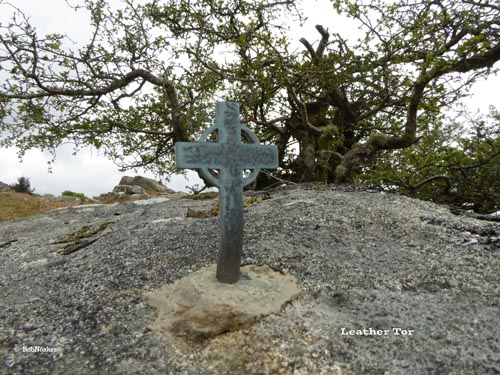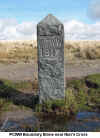 Location: Cemented
into the top of a large boulder in the Leather Tor area. Location: Cemented
into the top of a large boulder in the Leather Tor area.
Grid Ref: Due
to the fact that other similar crosses on the moor have been either stolen
or damaged, we have decided not to publish the exact location of this
cross.
Map location:
See above.
Purpose: Unknown.
Size: The
cross measures 3 inches (75 millimetres) high, 2
inches (48 millimetres) across the arms, with the depth of the arms being
½ inch (13 millimetres).
Information:
This little metal cross has been cemented into position at
the top of a large boulder in the Leather Tor area. The cross is of
Celtic design, with the metal circle joining the head and arms with the
shaft. The name 'BUNTY' has been engraved across the arms of the
cross, but the significance of this name is not known to us. We've not been able to find out who put this cross out on the
moor or their reason for doing so. If anyone can help with this
information we'd be more than pleased to hear from you. Please contact
either: maurice.daniel.007@gmail.com
or Glenn.bearne@btinternet.com.  Leather
Tor sits well above the north-eastern end of Burrator Reservoir with the
imposing Sheeps Tor rising above the opposite bank of the reservoir.
The original reservoir was completed in 1898 under the supervision of
Edward Sandeman, who was the Water Engineer for the City of
Plymouth. The reservoir has two dams at its southern end with one
over the River Meavy and the second one built along the ridge between the
Meavy and the Sheepstor Brook.
This gave the reservoir a capacity of 668 million gallons of water.
Early in the 20th century it was realised that the reservoir was too small
to keep pace with the demands placed upon it by Leather
Tor sits well above the north-eastern end of Burrator Reservoir with the
imposing Sheeps Tor rising above the opposite bank of the reservoir.
The original reservoir was completed in 1898 under the supervision of
Edward Sandeman, who was the Water Engineer for the City of
Plymouth. The reservoir has two dams at its southern end with one
over the River Meavy and the second one built along the ridge between the
Meavy and the Sheepstor Brook.
This gave the reservoir a capacity of 668 million gallons of water.
Early in the 20th century it was realised that the reservoir was too small
to keep pace with the demands placed upon it by  the population of Plymouth
and the height of both dams was raised by 10 feet. This work was
completed in 1928 with the result that the capacity was raised, by 358
million, to 1026 million gallons of water. Many of the local farms
in the valley were compulsorily purchased during the building process,
either because they would be flooded under the water level or were sited
in the watershed and had to be abandoned to prevent the risk of
pollution. The greater area of the watershed is marked by a number
of large boundary stones, each inscribed with 'PCWW' (Plymouth City Water
Works) and the year that the stone was placed out onto the moor. The
reservoir is now one of several managed by the South West Lakes Trust. the population of Plymouth
and the height of both dams was raised by 10 feet. This work was
completed in 1928 with the result that the capacity was raised, by 358
million, to 1026 million gallons of water. Many of the local farms
in the valley were compulsorily purchased during the building process,
either because they would be flooded under the water level or were sited
in the watershed and had to be abandoned to prevent the risk of
pollution. The greater area of the watershed is marked by a number
of large boundary stones, each inscribed with 'PCWW' (Plymouth City Water
Works) and the year that the stone was placed out onto the moor. The
reservoir is now one of several managed by the South West Lakes Trust.
Our thanks to Bob Noakes for
bringing this cross to our attention and for providing the main photo
(above right).
|
 Location: Cemented
into the top of a large boulder in the Leather Tor area.
Location: Cemented
into the top of a large boulder in the Leather Tor area.